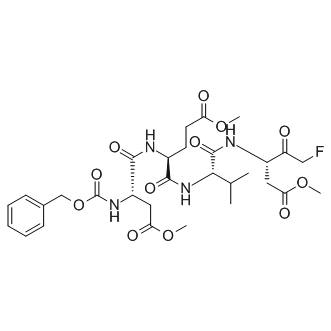| Description: |
Z-DEVD-FMK is a specific and irreversible caspase-3 inhibitor with IC50 of 18 μM. |
| Target: |
Caspase-3:18 μM (IC50) |
| In Vivo: |
Early Z-DEVD-FMK (160 ng) treatment improves motor and cognitive function after traumatic CNS injury induced by severe controlled cortical impact (CCI) in the mouse[2]. Treatment with Z-DEVD-FMK (160 ng) significantly improves neurological outcome when compared with traumatized animals treated with DMSO vehicle (p<0.01)[3]. |
| In Vitro: |
N27 cells are exposed to MPP+ in the absence or presence of 50 μM Z-DIPD-FMK or 100 μM Z-DEVD-FMK or 50 μM Z-LEHD-FMK and then caspase-9 and caspase-3 enzymatic activities are determined by enzymatic assay at 12 and 24 h following exposure, respectively. Exposure to 300 μM MPP+ for 24 h in N27 cells results in an approximately 2.5-fold increase in caspase-3 enzyme activity. MPP+-induced increases in caspase-3 enzyme activity are significantly blocked by 50 μM Z-DIPD-FMK, 100 μM Z-DEVD-FMK, and 50 μM Z-LEHD-FMK[1]. |
| Cell Assay: |
N27 cells and primary mesencephalic neurons are exposed to either 10-100 μM 6-OHDA or 10-300 μM MPP+ in the presence or absence of 0.1-50 μM Z-DIPD-FMK or 0.1-100 μM Z-DEVD-FMK or 50 μM Z-IETD-FMK or Z-LEHD-FMK for the duration of the experiment. N27 cells are incubated with 100 μM 6-OHDA for 24 h or 300 μM MPP+ for 36 h in the presence or absence of 50 μM Z-DEVD-FMK and cell death is determined by MTT assay, which is widely used to assess cell viability. After treatment, the cells are incubated in serum-free medium containing 0.25 mg/mL MTT for 3 h at 37°C. Formation of formazan from tetrazolium is measured at 570 nm with a reference wavelength at 630 nm using a SpectraMax microplate reader[1]. |
| Animal Administration: |
Mice[2] Male C57Bl/6 mice (20-25 g) are used. For treatment with Z-DEVD-fmk or vehicle after CCI, mice are reanesthetized with isoflurane at various times after injury, placed in a stereotaxic apparatus, and the CCI wound is reopened for intracerebroventricular injection. Either Z-DEVD-FMK (160 ng in 2 μL DMSO), or DMSO vehicle is injected over a 5-minute period. Rats[3] Male Sprague Dawley rats (425±25 g) are used. DMSO (5 μL) vehicle or Z-DEVD-FMK (160 ng in 5 μL of DMSO) is administered at a controlled rate of 0.5 μL/min via an infusion pump at 30 min before and at 6 and 24 hr after TBI. At the designated time periods after injury, animals are decapitated under sodium pentobarbital anesthesia (100 mg/kg, i.p.), and the brains are removed rapidly and dissected. Sham-operated (control) animals received anesthesia and surgery but are not subjected to trauma. Tissue samples are collected 1, 4, 12, 24, and 72 hr after TBI. Samples are frozen on dry ice and kept at −85°C. |
| References: |
[1]. Kanthasamy AG, et al. A novel peptide inhibitor targeted to caspase-3 cleavage site of a proapoptotic kinase protein kinase C delta (PKCdelta) protects against dopaminergic neuronal degeneration in Parkinson's disease models. Free Radic Biol Med. 2006 Nov 15;41(10):1578-89.
[2]. Knoblach SM, et al. Caspase inhibitor z-DEVD-fmk attenuates calpain and necrotic cell death in vitro and after traumatic brain injury. J Cereb Blood Flow Metab. 2004 Oct;24(10):1119-32.
[3]. Yakovlev AG, et al. Activation of CPP32-like caspases contributes to neuronal apoptosis and neurological dysfunction after traumatic brain injury. J Neurosci. 1997, 17(19), 7415-7424.
[4]. Huang MY, et al. Chemotherapeutic agent CPT-11 eliminates peritoneal resident macrophages by inducing apoptosis. Apoptosis. 2016 Feb;21(2):130-42. |






















